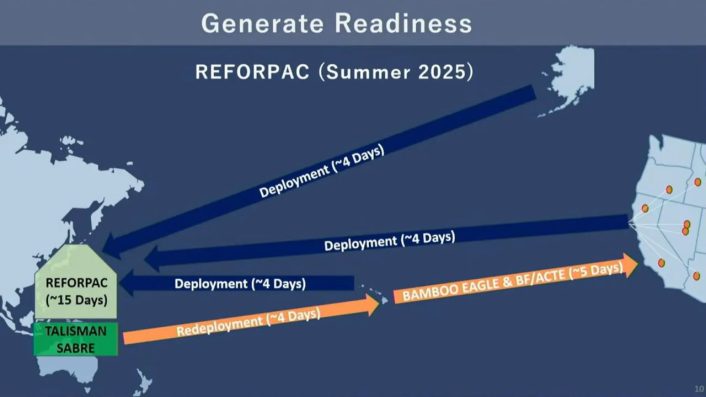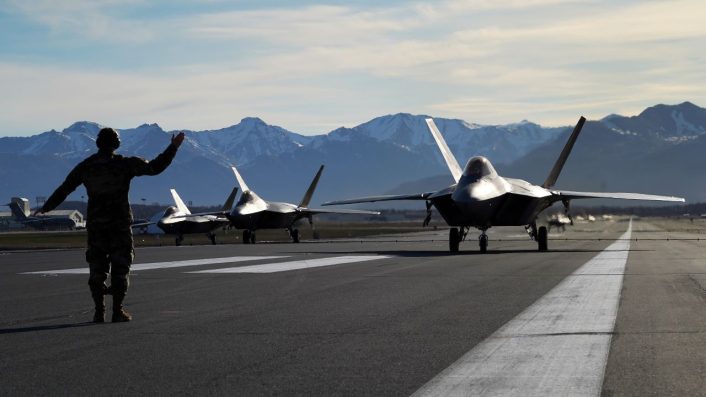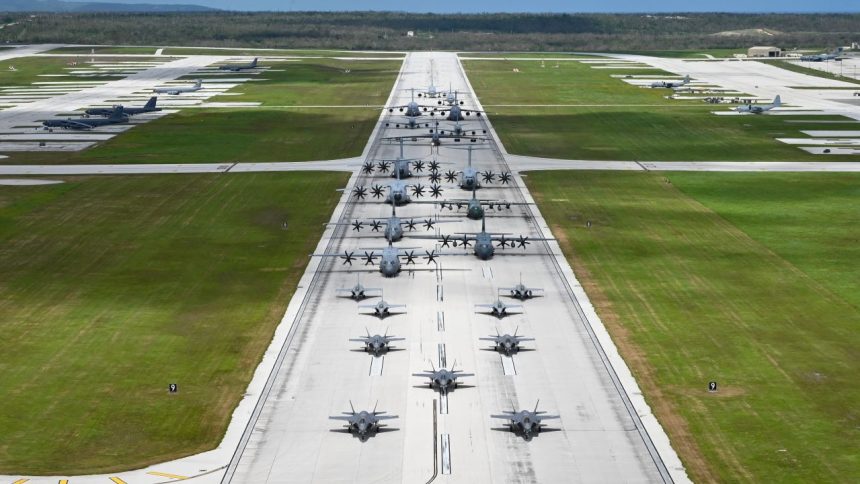REFORPAC and future large-scale exercises are being ‘evolved to generate readiness at the mission-level, rather than at the task-level.’
The U.S. Air Force will send units from across the country to the western Pacific in the summer of 2025 for an exercise designed to practice the way the service will mobilize and deploy in mass for a potential war with China. Called REFORPAC (Return of Forces to Pacific), the 14-day exercise will see units from Alaska, Hawaii, Guam, and the continental United States converging in the Pacific, Air Force chief General David Allvin said during a Hudson Institute event on Aug. 17.
The name is derived from the Cold War-era REFORGER (Return of Forces to Germany) in which the U.S. practiced transporting vast number of troops and material across the Atlantic during confrontations with the Soviet Union.
Allvin touched upon how the US and NATO were ready for a conventional war with a peer adversary then – a habit that was lost after the USSR disintegrated in 1991. The “Unipolar era” and the global war on terror for nearly three decades saw a different military environment, with the Air Force reorienting towards that purpose.
After 1991, the United States’ need for massive and sudden deployment both from the homeland and at the forward bases diminished. The Air Force sent a few squadrons at a time for the conflict in the Middle East, in what Allvin called “fragmented” deployments – woefully piecemeal for a high-end war in the Pacific. The effort is therefore to “re-optimize” for the emerging Great Power contest.

‘Exercise like we are fighting’
“We’re integrating REFORPAC into INDOPACOM’s campaign, combatant commanders’ exercises, plans and our Pacific Air Forces’ approach to supporting those in a way that is more robust and for a longer period of time,” Allvin said. US Northern Command and Strategic Command were the other combatant commands shown in his presentation, which use fighter, bomber, mobility or refueling wings for their own exercises.
His presentation included an illustration that represented deployments from Alaska, California, Guam and Hawaii for four days each to far northeast Asia, possibly Japan and South Korea for 14 days. The idea is for REFORPAC to practice collectively all the aspects of mobilizing for a war in the western Pacific, unlike other drills that, nonetheless important, practice elements of a large war. These can be identified as annual exercises like the Bayou Warrior, Prairie Vigilance or Bamboo Eagle.
Four U.S. #AirForce F-16 Fighting Falcons fly alongside a KC-135 Stratotanker over the western United States during Exercise Bamboo Eagle 24-3 … https://t.co/FAyE5Ocbdx pic.twitter.com/q9fsLrQNYl
— DVIDSHub (@DVIDSHub) August 11, 2024
“You can part task train this. But until you’re there, doing it over a period of time we’re not really going to uncover the works you might not have discovered while doing it in pieces. You have to do it in a realistic scenario,” said Allvin. Put differently, REFORPAC and possibly future large-scale exercises are being “evolved to generate readiness for mission, rather than readiness at the task level.”
REFORPAC would then be “rolled in” with Talisman Sabre, the annual and largest bilateral joint defense exercise between Australia and the United States. “[This is] because we understand we’re going to fight with allies and partners,” Allvin said.
Talisman Sabre has also evolved to now include a dozen countries and roughly 30,000 personnel, and is expected to be even bigger in 2025. In its 2023 iteration, the JGSDF (Japan Ground Self-Defense Force) fired an improved variant of its Type-12 anti-ship missile from Australian territory. American F-22s, KC-46s, and C-17s also participated then. USAF B-2 Spirit stealth bombers are currently in Australia for their first BTF (Bomber Task Force) mission in two years.

Current Exercises
The U.S.A.F’s recent exercises have indeed become more realistic and geared for combat with a peer competitor. But these are the unit and formation-level and the Air Force aims to mobilize all its fighter, mobility, bomber and refueler wings at once from across the country.
“We need to get back to those large scale exercises, and to their credit, many of the wing level, and the numbered air force level, and even some of the MAJCOM (major command) level (units), have started to organically expand their exercises,” Allvin said. “Red Flag exercises have become more expansive. The Weapon School integration (exercises) are becoming more combat representative.”
For instance, as The Aviationist had reported, Exercise Bamboo Eagle that concluded on Aug. 10, 2024, took place across several locations across California and the airspace over the Pacific Ocean. The exercise focused on distributed command and control, disaggregated mission generation and the joint maritime environment, and also exposed Airmen to sustained operational tempo under the threat of large-scale enemy fires.
Individually, we are one drop. Together we are an ocean.
一緒に私たちは海です。
An 8-ship #joint-coalition formation soars near Anderson Air Force Base, Guam during #CopeNorth21. #ReadyAF #PacificPartners @usairforce @INDOPACOM @DeptofDefense @AFGlobalStrike pic.twitter.com/3rincP8VwW
— PACAF (@PACAF) February 12, 2021
Another instance are the four F-22 Raptors from the 27th Expeditionary Fighter Squadron from Joint-Base Langley-Eustis in Virginia which made a DFE (Dynamic Force Employment) visit to Indonesia’s I Gusti Ngurah Rai Air Force Base. The ongoing Ulchi Freedom Shield 24 with the Republic of Korea Air Force this year is also seeing the incorporation of ACE (Agile Combat Employment) by the F-16 flying 8th and 51st Fighter Wings.
Two B-52 Stratofortress bombers from Minot AFB in North Dakota also recently made a “rare deployment” to Alaska on Jul. 25, to join the Arctic Defender exercise that was underway. Interestingly, the Minot bomber crews treated the deployment to Alaska as an extension of their own Agile Warbird, an ACE drill. Several B-52s and airmen from Minot also arrived at Fairchild and Dyess AFBs at Washington and Texas respectively for the ACE practice on Jul. 15.









